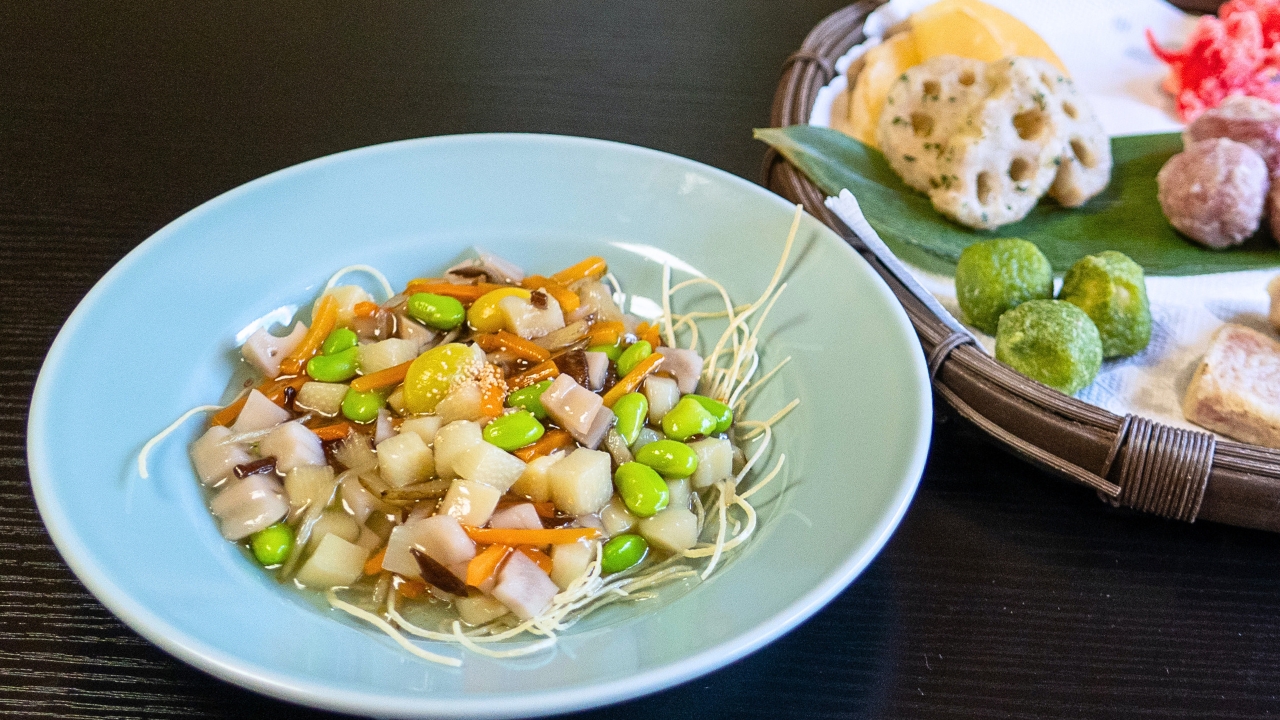Blog
[Kyoto] Visit Manpuku-ji Temple for Shōjin Ryōri, a Buddhist Vegetarian Cuisine

Content
What is Shōjin Ryōri, Buddhist Vegetarian Cuisine?
Buddhist precepts teach that one should not kill living creatures. And in order to adhere to this rule of non-violence, some Buddhist temples prepare a special type of vegetarian cuisine called Shōjin Ryōri. The cuisine uses no meat, fish, or other animal products.

The food is simple, yet flavorful, and relies on a wide variety of ingredients like wild vegetables, nuts, mushrooms, roots, bamboo shoots, flowers, rice, and plant-based protein sources such as grains, tofu, and miso.
The style of cooking was introduced to Japan as a result of cultural exchange with China as Japanese monks traveled to the mainland to further their Buddhist training. When they returned, the monks Eisai Myōan (1141-1215) and Dōgen Eihei (1200–1253) were particularly influential in spreading Zen Buddhism and the Shōjin Ryōri culinary style. While adhering to the precepts of Buddhism, Shōjin Ryōri manages to strike a remarkable balance between abundance and austerity.
Experience Shōjin Ryōri at Manpuku-ji Temple in Kyoto

Eating Shōjin Ryōri gives you a chance to taste the unique flavors of temple food and get a glimpse into the philosophy behind it. There are several temples and restaurants in Kyoto where you can try Shōjin Ryōri. And while I’m sure they are all delicious, I chose to visit Manpuku-ji Temple in Uji City, a town famous for matcha and tea ceremony. Here they serve a unique style of Shōjin Ryōri called Fucha Ryōri, which has a more distinct Chinese influence. Foods are served on platters rather than in individual servings as meals are intended to be eaten with company. And many of the dishes are fried in vegetable oil giving them an extra edge on standard Buddhist cuisine.

Manpuku-ji is very easy to get to, located only a five minute walk from Obaku Station on the Keihan Electric Railway Uji line or the JR Nara line. To eat at the temple you must pay the admission fee of 500 yen per adult, which also allows you to explore the temple grounds and buildings.
Expertly Prepared Vegan Recipes Passed Down Generations
Each dish in my eight-course Fucha Ryōri meal was carefully prepared and beautifully presented. The meal started with goma-dofu, a type of tofu made from sesame and kudzu. The rich sesame flavor was complimented by the unusual soft chewiness unique to this type of tofu.
The next dish, a platter of simmered seasonal vegetables and preserved foods was full of variety. The green beans in the center of the plate were a clear nod to the Manpuku-ji founder, Zen-master Ingen Ryūki (1592–1673), for whom green beans have been named ingen-mame in Japanese. The most surprising item on this platter was the fake kamaboko (a pink and white fish cake common in Japanese cooking), which was actually made from mountain yam. Imitation foods, a hallmark of Fucha Ryōri, are delightful in that they look so much like the meat or fish that they are meant to resemble.

The platter of fried foods reminded me of tempura, but is sufficiently flavored to be eaten as is. It was gorgeous and included so many items that I had never tried fried before—red konjac, koya dofu coated in almond slices, and the fried plum, which takes five days to prepare!

Another stand-out dish was the unpen, which means cloud fragments and is a bed of crispy noodles topped with small bits of vegetables. Besides being delicious, the dish represents the philosophy of the kitchen to avoid waste and use every little piece of the precious foods which sustain us.

Of course the meal ended with a dessert assortment. Like the other courses, this was prepared using seasonal ingredients. Orange slices, served with hojicha dango (roasted green tea dumplings) and chestnut yōkan (a jellied sweet made from bean paste). It was the perfect end to a relaxing lunch in the company of friends.
Note, that to eat Fucha Ryōri you must make a reservation at least three days in advance, either in person or by phone. Course meals are offered in three tiers, starting at 6,600 yen per person. And because this type of Shōjin Ryōri is meant to be eaten with company, reservations for the course meals can only be made for groups of two or more. If you are dining alone, you may reserve a bento lunch box for 3,300 yen.
Head Temple of the Oubaku sect Manpuku-ji Temple
Address: 34 Sanbanwari, Gokasho, Uji City, Kyoto Prefecture
Hours: 9:00 am – 5:00 pm (Fucha Ryōri lunch 11:30 am – 2:30 pm, must be seated by 1 pm)
Website: https://www.obakusan.or.jp/en/
Fucha Ryori Information: https://www.obakusan.or.jp/eat/ (Japanese only)
Telephone: +81 0774-32-3900
Writer
Maisie McPherson
Originally from the United States, Maisie has called the Kansai region of Japan home for nearly two decades. She enjoys seeking out the charms of life in Japan and sharing that information with visitors from overseas. She also loves marveling at retro architecture and design from the Showa period, exploring Japanese gardens, and is always up for a night out in a lively izakaya.
